Location
The Serra da Tiririca State Park is divided between the municipalities of Niterói and Maricá, Rio de Janeiro. It has an area of 3,493 hectares (8,630 acres). This includes a marine park that extends 1,700 metres (5,600 ft) offshore between Pontas do Alto Mourão and Costão de Itacoatiara. It has rugged terrain with slopes above 50° in some places. The average altitude is around 286 metres (938 ft). The park includes eight hills, namely Morro do Elefante: 412 metres (1,352 ft), Alto Mourão: 369 metres (1,211 ft), Costão de Itacoatiara: 217 metres (712 ft), Morro do Telégrafo: 357 metres (1,171 ft), Morro do Catumbi: 325 metres (1,066 ft), Morro da Penha: 128 metres (420 ft) and Morro da Serrinha: 277 metres (909 ft).
History
The Serra da Tiririca region has many archaeological sites, particularly in Itaipu, which has important sambaquis (middens) left by different groups of indigenous people. When European settlers arrived the region was inhabited by Tamoios people. In the mid-16th century the Jesuits erected buildings in Itaipu to catechize the local people. Charles Darwin commented on the biological diversity when he visited in 1832 en route to Cabo Frio.
Creation of the park was due to a campaign by civil society against damage to the environment that began in the early 1980s and included environmental groups, residents' associations and other residents of the region. A Public Civil Action, the first in Brazil, was filed by the Public Prosecutor against an illegal subdivision. The Tiririca Front was active in 1989-90 but lost support due to its overly politicized activity. After this the Ecological Citizenship Movement (MCE) led development of a study to prepare the technical and legal basis for the park, including a draft built that was forwarded to the state legislature through Carlos Minc.
The Serra da Tiririca State Park was created by state law 1.902 of 29 November 1991 with the objective of protecting the Atlantic Forest vegetation, sources of watercourses and fauna. The provisional limits were defined by state decree 18.598 of 19 April 1993. On 10 October 1992 UNESCO recognized the park as part of the Atlantic Forest Biosphere Reserve. A 386-page guide to the park was published in June 2016 describing all the trails in the park, with 15 trails described in detail.

Niterói is a municipality in the state of Rio de Janeiro, in the southeast region of Brazil. It lies across Guanabara Bay, facing the city of Rio de Janeiro and forming part of the Rio de Janeiro Metropolitan Area. It was the capital of Rio de Janeiro, as marked by its golden mural crown, from 1834 to 1894 and again from 1903 to 1975. It has an estimated population of 515,317 inhabitants (2020) and an area of 129.375 km2 (49.952 sq mi), making it the fifth most populous city in the state. It has the highest Human Development Index in the state and the seventh highest among Brazil's municipalities in 2010. Individually, it is the second municipality with the highest average monthly household income per capita in Brazil and appears in 13th place among the municipalities of the country according to social indicators related to education. The city has the nicknames of Cidade Sorriso.
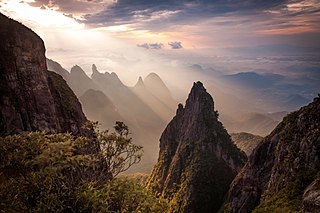
Serra dos Órgãos National Park is a national park in the state of Rio de Janeiro, Brazil. It protects the Serra dos Órgãos mountain range and the water sources in the range. It was the third national park to be created in Brazil.
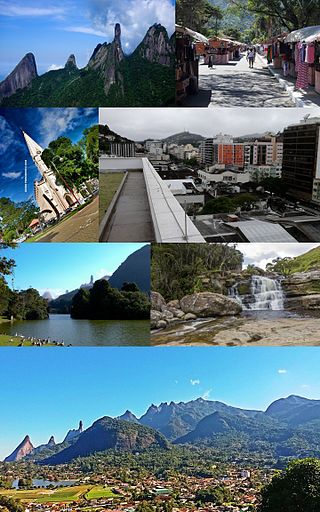
Teresópolis is a Brazilian municipality located in the state of Rio de Janeiro, in a mountainous region known as Região Serrana. The Serra dos Órgãos National Park lies partly within the city limits. The city is known as the home of the Brazil national football team, since it hosts CBF's training ground at Granja Comary.
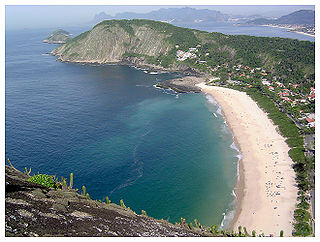
Itacoatiara is one of the 48 official neighborhoods into which the city of Niterói, Rio de Janeiro in Brazil is divided.

Maricá is a municipality located in the Brazilian state of Rio de Janeiro.

São Gonçalo is a municipality in Rio de Janeiro, Brazil, in the Southeast region. It is located in the Metropolitan Region of Rio de Janeiro, having land limits with the municipalities of Niterói, Maricá and Itaboraí, and a maritime limit, by Guanabara Bay, with the capital, Rio de Janeiro. According to the 2022 census, it has a population of 896,744 inhabitants, making it the second most populous municipality in the state and the 18th most populous in the country.

Terminalia acuminata is a tree species in the Combretaceae family. It was endemic to the Atlantic Forest in Brazil. The species was believed to be extinct in the wild from habitat loss, entering the IUCN Red List in 1998, with two individuals remaining in the Rio de Janeiro Botanical Garden.
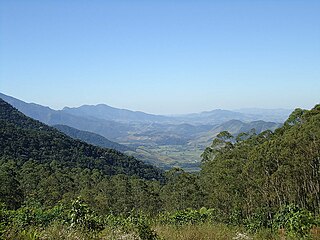
The Mantiqueira Mosaic is a protected area mosaic that contains conservation units in the states of Rio de Janeiro, São Paulo and Minas Gerais, Brazil. The conservation units are of different types and are managed at the federal, state or municipal level. The mosaic provides a level of integrated and coordinated management.
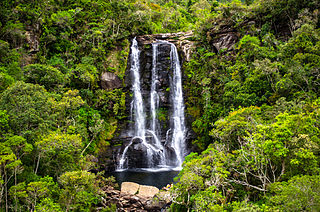
The Serra do Papagaio State Park is a state park in the state of Minas Gerais, Brazil. It protects a mountainous region of Atlantic Forest.

The Pedra Selada State Park is a state park in the state of Rio de Janeiro, Brazil.

The Três Picos State Park is a state park in the state of Rio de Janeiro, Brazil. It preserves a large, mountainous region of Atlantic Forest.

The Carlos Botelho State Park is a state park is the state of São Paulo, Brazil. It protects a mountainous area of Atlantic Forest. The park contains more than half of Brazil's remaining population of endangered southern muriqui, the largest primate in the Americas other than man.
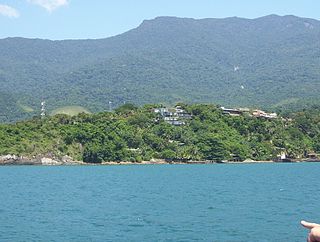
The Ilhabela State Park is a state park in the state of São Paulo, Brazil. It protects an area of Atlantic Forest on an archipelago in the South Atlantic off the northeast coast of the state, including most of the mountainous island of São Sebastião.
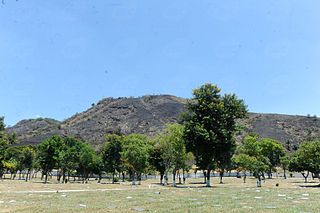
The Pedra Branca State Park is a state park in the state of Rio de Janeiro, Brazil. It is one of the largest urban nature parks in the world. It protects an area of Atlantic Forest in the west of the city of Rio de Janeiro that includes the highest point in the city, the Pico da Pedra Branca.

The Restinga de Bertioga State Park is a state park in the state of São Paulo, Brazil. It protects an area of restinga, mangroves and dense rainforest on the coast of São Paulo. The park provides an important ecological corridor from the coastal restinga to the Serra do Mar State Park further inland.
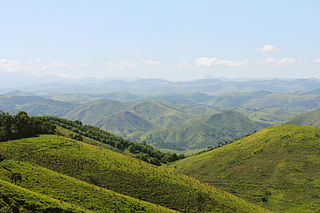
The Serra da Concórdia State Park Portuguese: Parque Estadual da Serra da Concórdia is a state park in the state of Rio de Janeiro, Brazil. It protects an area of Atlantic Forest.

The Serra Negra State Park Portuguese: Parque Estadual da Serra Negra is a state park in the state of Minas Gerais, Brazil. It protects a mountainous area in the Atlantic Forest biome, an important source of water in a dry region, and a potential source of tourism revenue in an area with many social problems.

The Rio Vermelho State Park Portuguese: Parque Estadual do Rio Vermelho is a state park in the state of Santa Catarina, Brazil. It protects an area of restinga, dense rainforest and land modified by exotic plantations which is to be restored. The park provides a green space for visitors from the nearby state capital of Florianópolis. It features an ecological trail where visitors may see and learn about wild animals rescued from abuse by the environmental police.

The Juatinga Ecological Reserve is an ecological reserve in the state of Rio de Janeiro, Brazil. It protects a rugged peninsula projecting into the Atlantic Ocern that is mainly covered by Atlantic Forest, and also helps maintain the traditional lifestyle of residents of small villages along the coast.
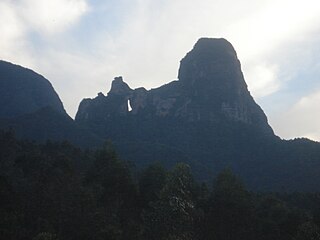
The Serra Furada State Park is a state park in the state of Santa Catarina, Brazil. It protects a densely forested mountain region in the Atlantic Forest biome.





















